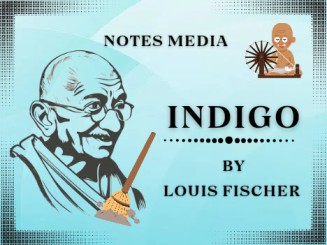Title of the Indigo
Indigo is a crop cultivated during British times in large quantities. It also describes the Champaran episode where there was a dispute between Share Croppers and British Landlords.
The Theme of the Indigo
The Theme of the chapter gives emphasis on Self Reliance one needs to own to win any battle. The author describes the Champaran episode and reveals how Gandhi ji taught the lesson of self-reliance to the people in India.
Character Sketch of the Indigo
- Raj Kumar Shukla: Raj Kumar Shukla is a poor peasant who is the victim of the British Landlord System. In this chapter, he shows the character of sincere, resolute, and determined. Despite of uneducated he stands against the British System and called Gandhi Ji to visit Champaran and sort out the matter of this unfair system.
- Gandhi Ji: Gandhi Ji is a famous freedom fighter who walks on the path of Non-Violence and Satyagraha. In this chapter Gandhi Ji plays an important role in uplifting the standards of the people of Champaran. He also helps them against the British Landlord System and teaches the peasants about their rights and self-reliance importance.
Read More: The Rattrap by Selma Langerlof Class 12 Detailed Explanations.
Summary of the Indigo
The Chapter Indigo narrates Gandhi Ji’s Struggle for the poor peasant of Chamaparan. Peasants under British Rule were Share Croppers who were able to cultivate 15% Indigo in their farms and had to surrender the whole harvest as a tax to the British Government.
The Chapter starts with the Gandhi Ji’s going back to Lucknow to attend a party meeting of the Indian National Congress in December 1916. When the poor peasant named Raj Kumar Shukla came to meet him and requested to come to Champaran to resolve the dispute with the British Landlord who had cheated them by taking compensation of 15% arrangement but did not reveal that Germany had already developed Synthetic Indigo which resulting in zero demand of their Indigo Crop. Gandhi Ji first decided to go to Patna to meet Doctor Rajendra Prasad who was out of town so he waited for him but at that place their servants ill-treated him. Then he moved to Muzzafarpur on 15th April 1917 to get some information where Professor J.B. Kripalani and his Students welcomed him. Then he called a lawyer and scolded them for charging fees from peasants who were handling the case of the sharecropper.
After this Gandhi Ji arrived in Champaran and visited the British Landlord Association but he was an outsider so he did not get any information. He then moved to Trihut to meet the commissioner and he too refused to cooperate and asked him to leave Trihut. Ghandi ji instead of leaving proceeded to Motihari where he was asked again to leave by the Superintendent of Police’s Messager. Gandhi refused and he had to present in front of the Court there he said that whatever he did was just due to conflicts of duties after two-hour trials. He was set in the Civil Disobedience War for the first time in modern India. As a result, Sir Edward Gait and the Lieutenant Governor set up a commission for the Peasant’s case and the commission amount Gandhi Ji said was 25% of the Compensation amount. Gandhi Ji said that the amount was not important but with that amount, the Britishers also surrendered their Prestige and that victory removed the fear from the minds of peasants. Then Gandhi Ji worked for the Social and Cultural upliftment of the peasants of Champaran. He opened 6 Schools in the village of Champaran and called volunteers to teach personal hygiene including his elder son Devdas and his wife Kasturbai. Later with the help of doctors he provides medical facilities for the people of the Champaran. Andrew also wants to join in volunteering for the people of Champaran in Ashram but Gandhi Ji refused him and said it’s time for Indians to learn the lesson of self-reliance. This incident marks a great impact on the mind of the writer that we did not need any outsider advice to run our country.
Read More: Poet and Pancake by Asokamitran Class 12 Detailed Explanations.
Conclusion of the Indigo
From this chapter, we conclude that anything is possible if we fight against injustice and problems. We should understand the value of self-reliance and not depend on other for work.
Social Link of Page
- Instagram: Click Here
- Whatsapp Community: Click Here
- Youtube: Click Here
Important Question of the Indigo
Why Did the servant think Gandhi ji to be another peasant?
When Gandhi Ji visited Dr. Rajendra Prasad’s house with Raj Kumar Shukla. Then the servant of Dr. Rajendra Prasad already knows about Raj Kumar Shukla who always troubles their master and they did not know who was Gandhi. So due to this the servant ill-treated both Gandhi Ji and Raj Kumar Shukla and sat them on the ground and moreover, they did not allow Gandhi Ji to draw water from the well.
What were the terms of the indigo contract between the British Landlord and the peasant?
The whole fertile land was divided into large estates which were owned by Britishers and farmers worked as a peasant. They had to grow 15% Indigo on the farm and the rest should be surrendered to the British Government.
Though the share cropper received only 25% of the compensation but still Champaran Battle is termed as huge success. Why?
No doubt, Share Croppers received only 25% of the compensation but with that Britishers had to surrender their prestige, and moreover, this incident made peasants fearless and aware of their rights.
Why Did Gandhi oppose to Andrew who helped him in the Champaran Episode?
Gandhi Ji by this Champaran incident wanted to teach the lesson of Self Reliance to the people. So by taking the help of Andrew, it would create the wrong impression.
Why is Raj Kumar Shukla described as being resolute?
Raj Kumar is a poor peasant from Champaran, who urged Gandhi Ji to come to Champaran and help the sharecropper. He is so determined that he follows Gandhi whenever he wants which shows the quality of dedication and resolution toward work.
Read More: A Roadside Stand by Robert Frost Class 12 Detailed Explanations.






